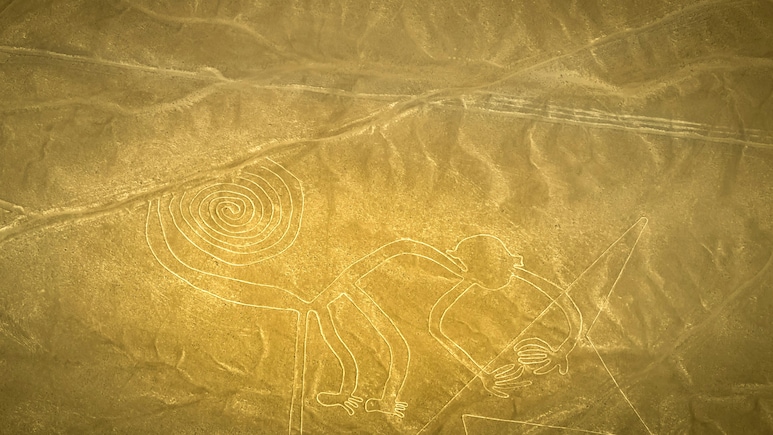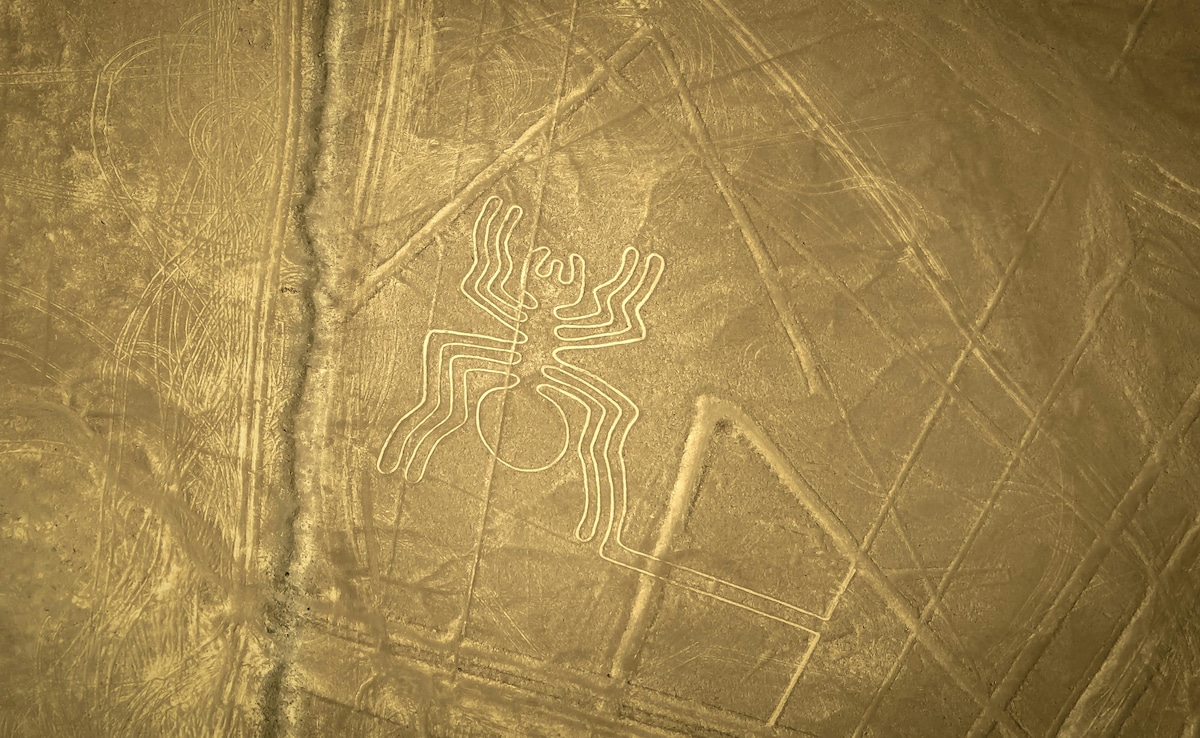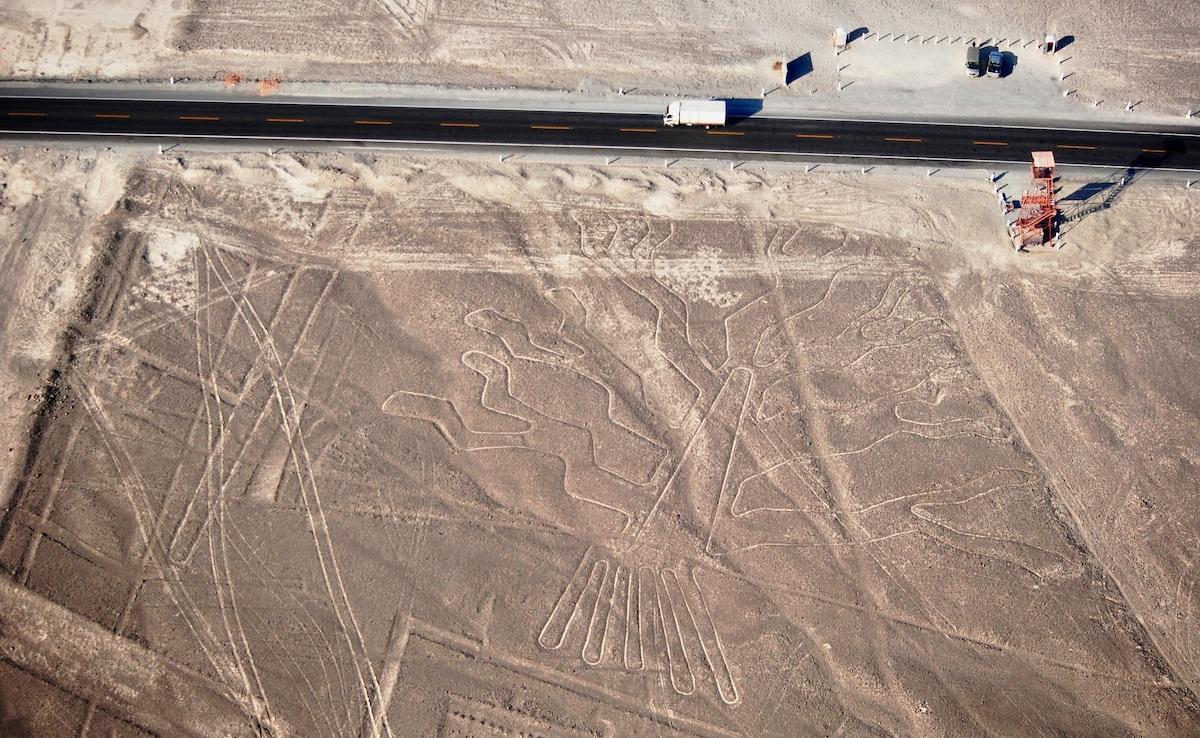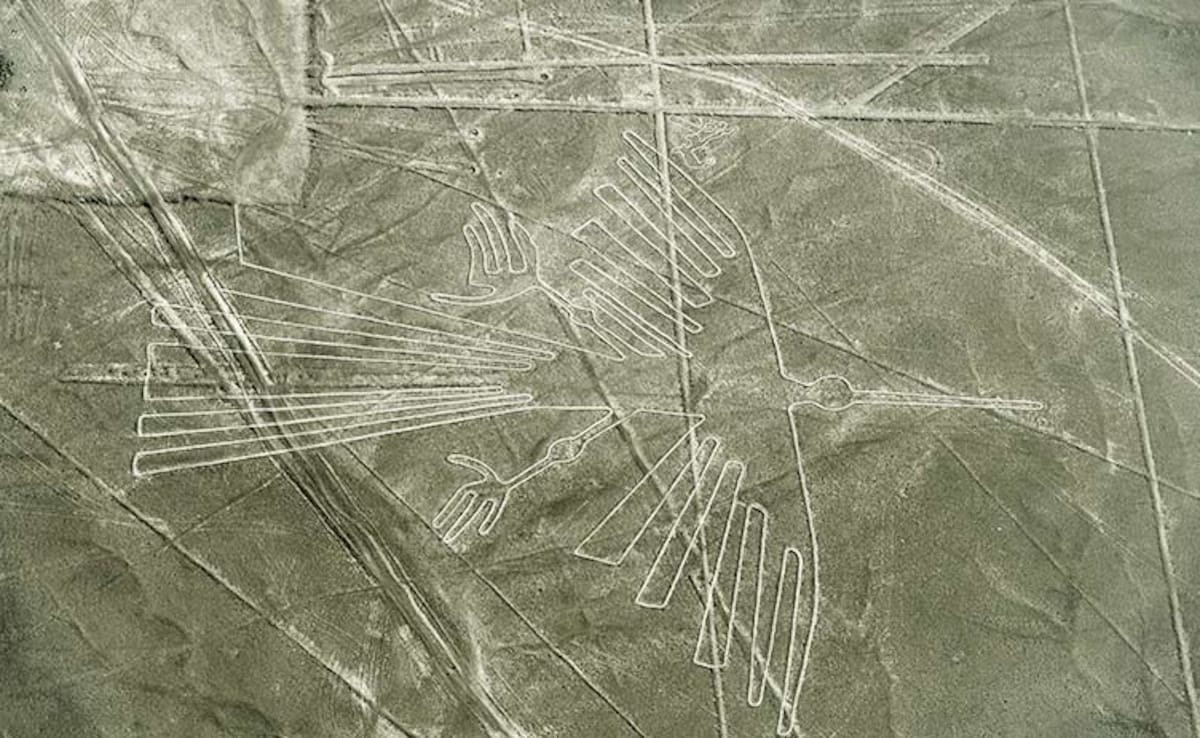
The world is full of wonders that defy logic. From ancient temples aligned with the stars to underwater cities lost to time, some destinations go beyond explanation, and that is exactly what makes them worth exploring. For curious minds and culture seekers, these mysteries are not just travel stops but invitations to think deeper, question more, and feel the thrill of the unknown. One such place lies in the desert plains of southern Peru. It is the Nazca Lines - massive geoglyphs etched into the earth. This has puzzled archaeologists, historians, and travellers for decades. Visible only from the sky, these giant drawings of animals, plants, and geometric shapes stretch across the landscape with eerie precision.
But the question here is - Who made them and why? And how have these lines survived thousands of years in one of the driest places on Earth? Let's find out.
Also Read: Ajanta And Ellora Caves: 9 Fascinating Facts You May Not Know
What Are The Nazca Lines And Where Are They Located?
The Nazca Lines are a collection of enormous geoglyphs - designs carved into the desert floor - believed to be created by the ancient Nazca civilisation between 200 BCE and 500 CE. Located in the Pampa Colorada, just northwest of the town of Nazca and about 400 km southeast of Lima, these lines span an area of nearly 170 square miles.
From the ground, the lines appear as shallow grooves in the reddish soil. But from above, they reveal intricate shapes: hummingbirds, monkeys, spiders, trees, and abstract patterns. Some figures stretch over 300 feet, and many lines run for miles across the desert. The technique used was surprisingly simple - removing the top layer of oxidised stones to expose the lighter earth beneath. Despite their scale and age, the Nazca Lines have remained remarkably intact, thanks to the region's dry climate and lack of wind. Their visibility from the air has sparked countless theories, making them one of the world's greatest travel mysteries.
Also Read: Amer Fort Jaipur: 7 Secrets They Never Told You About This UNESCO Site

Photo Credit: Pexels
6 Fascinating Facts About The Nazca Lines:
1. Over 1,200 Designs That Defy Logic
The Nazca Lines are not just a handful of drawings. They are a vast desert canvas with over 1,200 distinct designs. These include 800 straight lines, 300 geometric shapes, and 70 biomorphic figures, stylised representations of animals, plants, and humans. Among the most iconic are the hummingbird, monkey, spider, whale, and hands. Each figure is etched with remarkable precision, suggesting a deep understanding of proportion and scale. The sheer variety and complexity of these designs continue to intrigue archaeologists and travellers alike.
2. Massive Scale That Can Only Be Seen From The Sky
Some Nazca Lines stretch up to 30 miles across the desert, while individual figures like the hummingbird span over 320 feet, roughly the height of a 30-storey building. From the ground, these lines appear as shallow grooves, barely noticeable. But from the air, they transform into massive, symmetrical artworks. This aerial visibility has led to theories about ancient flight, celestial observation, and even extraterrestrial contact. Regardless of the origin, the scale alone makes the Nazca Lines one of the most ambitious artistic undertakings in human history.
3. Simple Technique, Grand Impact
Despite their grandeur, the Nazca Lines were created using a surprisingly simple method. The ancient Nazca people removed the top layer of dark, oxidised stones to expose the lighter soil beneath, creating a contrast that remains visible even today. No advanced tools were used. It was all done with just wooden pegs, ropes, and keen surveying skills. This technique, combined with the region's dry climate and lack of wind, has helped preserve the lines for over two millennia. It is a testament to how ancient ingenuity can rival modern engineering.
4. Cultural Continuity And Spiritual Significance
The Nazca Lines are believed to reflect the spiritual beliefs and rituals of the Nazca civilisation. Living in one of the driest regions on Earth, the Nazca people worshipped nature deities and performed ceremonies to invoke rain and fertility. Many lines are thought to be ritual pathways, walked during processions or offerings. The figures may represent mythical beings, cosmic symbols, or agricultural prayers. This cultural continuity links the lines not just to art, but to survival, spirituality, and community identity.
5. AI Discoveries That Keep The Mystery Alive
In recent years, researchers have used artificial intelligence and satellite imaging to uncover over 140 new geoglyphs, some so faint they were previously invisible to the human eye. These discoveries include humanoid figures, feline shapes, and abstract patterns, expanding our understanding of the Nazca people's symbolic language. The use of AI has opened new doors in archaeology, proving that even ancient mysteries can evolve with modern technology. It also suggests that many more lines may still be hidden beneath the desert's surface.
6. Animal Symbolism That Speaks Across Time
Each Nazca figure carries symbolic meaning rooted in the region's ecology and mythology.
- The spider is believed to represent rain, crucial for agriculture
- The hummingbird symbolises fertility and renewal
- The monkey, with its curled tail, may indicate trade links with the Amazon basin
- The condor and whale reflect the Nazca people's connection to both land and sea
These symbols were not random, they were chosen with intention, possibly as part of ritual offerings, astronomical alignments, or spiritual storytelling.
Also Read: 6 UNESCO World Heritage Sites In India That Are Totally Worth The Hype
Popular Theories Behind The Mystery Of The Nazca Lines:
Despite decades of research, the true purpose of the Nazca Lines remains one of archaeology's most enduring puzzles. These massive geoglyphs, etched into Peru's desert floor over 2,000 years ago, continue to spark debate among historians, scientists, and curious travellers. Here are the most compelling theories that attempt to decode their meaning:
1. Astronomical Calendar
One of the earliest and most widely accepted theories comes from Paul Kosok, an American historian, and Maria Reiche, a German mathematician and archaeologist. They believed the lines were part of a vast astronomical calendar, used to track solstices, equinoxes, and star alignments.
Reiche famously called the Nazca desert "the largest astronomy book in the world," noting that many lines point to the rising and setting of celestial bodies. This theory suggests the Nazca people had a deep understanding of the cosmos and used the lines to mark seasonal changes, crucial for agriculture in such an arid region.
2. Ritual Pathways For Water Worship
In a desert that receives less than an inch of rain annually, water was sacred. Johan Reinhard, a National Geographic explorer and anthropologist, proposed that the lines were part of ritual pathways used in ceremonies to invoke rain and fertility.
Many geoglyphs are located near ancient aqueducts and ceremonial platforms, suggesting they were walked during processions or offerings to water deities. The spider, often associated with rain in Andean mythology, supports this theory. This interpretation connects the lines to spiritual ecology, where art, ritual, and survival were deeply intertwined.
3. Alien Runways And Extraterrestrial Theories
Popularised by authors like Erich von Daniken, this theory suggests the Nazca Lines were created for, or by, extraterrestrial beings. The argument hinges on the fact that the lines are only visible from the air, leading some to speculate they were landing strips or messages to space travellers.
While this idea has captured the imagination of pop culture and sci-fi fans, it lacks archaeological evidence and is not supported by mainstream researchers. Still, it remains one of the most searched and discussed theories online.
4. Symbolic Art And Cultural Expression
Another grounded theory views the lines as symbolic art, created to express cultural identity, mythology, and spiritual beliefs. Some figures may represent deities, animals of power, or cosmic forces, while others could be part of pilgrimages or fertility rituals. Archaeologists have found platforms near many geoglyphs, possibly used for offerings or performances. This theory positions the Nazca Lines as a form of land art, where the desert itself became a canvas for storytelling and ceremony.
Also Read: World Wonders: 5 Countries With The Most UNESCO World Heritage Sites

Photo Credit: Pexels
How To Visit The Nazca Lines?
1. Flyover Tours: The Best Way To See The Lines
The most immersive way to view the Nazca Lines is by booking a 30-minute flight from Nazca Airport, located near the town of Nazca in southern Peru. Small aircraft, typically seating 4 to 6 passengers, fly at low altitudes to give you sweeping views of the most iconic geoglyphs, including the Monkey, Spider, Condor, Hummingbird, and the mysterious Astronaut figure.
- Flight Cost: Typically ranges from 70 to 100 USD, depending on the season and operator
- Best Time To Fly: Morning flights (7 AM to 10 AM) offer the clearest skies and smoothest air conditions
- Booking Tip: Choose operators with certified pilots and transparent safety records. Some flights include commentary or printed maps to help identify the figures.
- Travel Tip: Carry a wide-angle lens for landscape shots and binoculars for spotting finer details. Sit on the right side of the plane for the best views on outbound flights.
2. Viewing Towers: Budget-Friendly Ground Perspective
If flying is not an option, you can still catch a glimpse of the Nazca Lines from the ground. The Mirador de Nazca, a metal viewing tower located along the Pan-American Highway, offers elevated views of three nearby figures: the Tree, the Hands, and part of the Lizard (which was partially cut by the highway).
- Entry Fee: Around 3 soles (INR 65)
- Access: Reachable by local bus or colectivo from Nazca town
- Experience: While the view is limited compared to aerial tours, it offers a close-up look at the craftsmanship and scale of the lines
Bonus Tip:
After visiting the tower, walk to the nearby natural hill lookout, considered sacred by locals. Many lines point toward this hill, and it offers a panoramic desert view.
Can You Walk On the Nazca Lines?
No, walking on the Nazca Lines is strictly prohibited. These ancient geoglyphs are part of a protected UNESCO World Heritage Site, and any physical contact with the lines can cause irreversible damage to their delicate structure. The desert's dry climate has preserved them for over 2,000 years, but human interference, especially foot traffic, can quickly erode the shallow grooves that define each figure. In fact, past incidents of trespassing have led to legal action and tighter restrictions. Visitors are encouraged to admire the lines from designated viewing platforms or aerial tours, which offer a safe and respectful way to experience their scale and mystery without harming this priceless cultural legacy.
Are The Nazca Lines Visible On Google Maps?
Yes, some of the Nazca Lines are visible on Google Maps and Google Earth, especially the larger and more distinct geoglyphs like the Hummingbird, Monkey, Spider, and Astronaut. However, due to their shallow depth and the desert's uniform colouring, many of the lines can be difficult to spot without zooming in or using precise coordinates.
Several websites and researchers have compiled interactive maps and GPS coordinates to help travellers and enthusiasts locate specific figures. For example, the Astronaut geoglyph can be found at approximately 14°44'42.71"S 75°4'47.24"W, and the Condor at 14°41'50.09"S 75°7'34.59"W. While Google Maps offers a general view, Google Earth provides better resolution and altitude control, making it easier to appreciate the scale and layout of the lines.

Photo Credit: iStock
Nearby Attractions Worth Exploring Around Nazca Lines:
1. Cahuachi Ceremonial Centre:
Once the largest ceremonial complex of the Nazca civilisation, this site features pyramids, plazas, and temples used for rituals and gatherings. It offers insight into the spiritual life behind the geoglyphs.
2. Cantalloc Aqueducts:
Ingenious underground water channels built over 1,500 years ago, still functioning today. These aqueducts showcase the Nazca people's engineering skills and their deep relationship with water in a desert landscape.
3. Maria Reiche Museum:
Dedicated to the German mathematician who spent her life studying and preserving the Nazca Lines. The museum houses her research, personal belongings, and aerial photographs that helped bring global attention to the site.
The Nazca Lines are not just ancient drawings; they are questions carved into the earth. Whether you believe they were made for gods, stars, or something else entirely, watching them is a humbling experience. They remind us that travel is not just about ticking off destinations, but about encountering the unknown. If you ever find yourself in Peru, take a flight over the desert and witness this silent masterpiece.
Track Latest News Live on NDTV.com and get news updates from India and around the world

